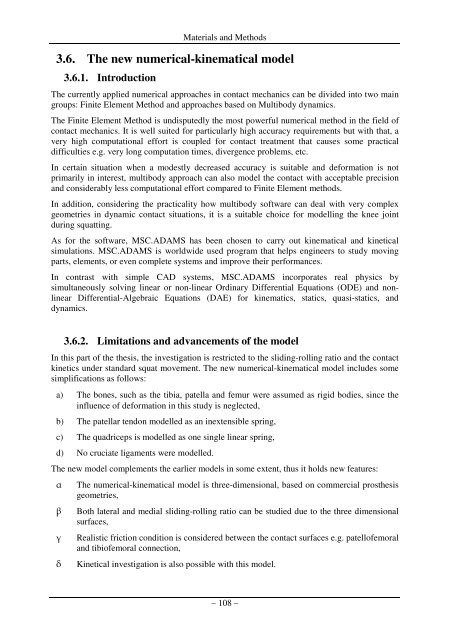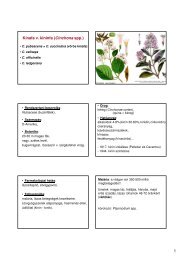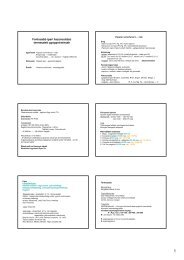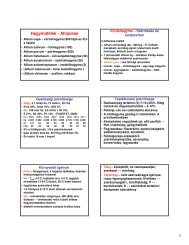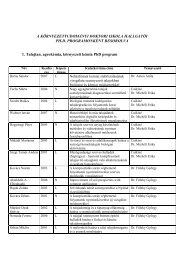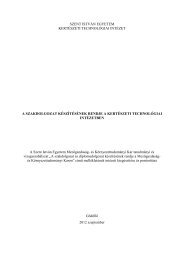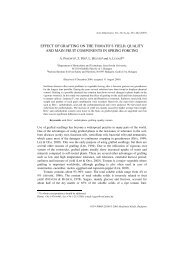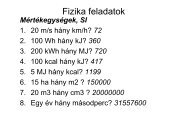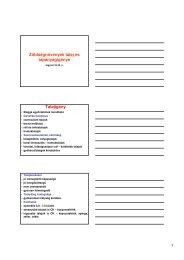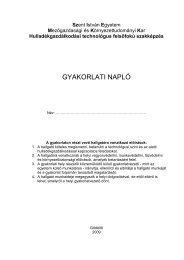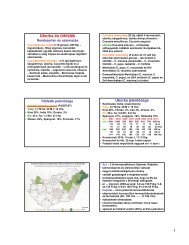PhD Fekete - SZIE version - 2.2 - Szent István Egyetem
PhD Fekete - SZIE version - 2.2 - Szent István Egyetem
PhD Fekete - SZIE version - 2.2 - Szent István Egyetem
Create successful ePaper yourself
Turn your PDF publications into a flip-book with our unique Google optimized e-Paper software.
Materials and Methods<br />
3.6. The new numerical-kinematical model<br />
3.6.1. Introduction<br />
The currently applied numerical approaches in contact mechanics can be divided into two main<br />
groups: Finite Element Method and approaches based on Multibody dynamics.<br />
The Finite Element Method is undisputedly the most powerful numerical method in the field of<br />
contact mechanics. It is well suited for particularly high accuracy requirements but with that, a<br />
very high computational effort is coupled for contact treatment that causes some practical<br />
difficulties e.g. very long computation times, divergence problems, etc.<br />
In certain situation when a modestly decreased accuracy is suitable and deformation is not<br />
primarily in interest, multibody approach can also model the contact with acceptable precision<br />
and considerably less computational effort compared to Finite Element methods.<br />
In addition, considering the practicality how multibody software can deal with very complex<br />
geometries in dynamic contact situations, it is a suitable choice for modelling the knee joint<br />
during squatting.<br />
As for the software, MSC.ADAMS has been chosen to carry out kinematical and kinetical<br />
simulations. MSC.ADAMS is worldwide used program that helps engineers to study moving<br />
parts, elements, or even complete systems and improve their performances.<br />
In contrast with simple CAD systems, MSC.ADAMS incorporates real physics by<br />
simultaneously solving linear or non-linear Ordinary Differential Equations (ODE) and nonlinear<br />
Differential-Algebraic Equations (DAE) for kinematics, statics, quasi-statics, and<br />
dynamics.<br />
3.6.2. Limitations and advancements of the model<br />
In this part of the thesis, the investigation is restricted to the sliding-rolling ratio and the contact<br />
kinetics under standard squat movement. The new numerical-kinematical model includes some<br />
simplifications as follows:<br />
a) The bones, such as the tibia, patella and femur were assumed as rigid bodies, since the<br />
influence of deformation in this study is neglected,<br />
b) The patellar tendon modelled as an inextensible spring,<br />
c) The quadriceps is modelled as one single linear spring,<br />
d) No cruciate ligaments were modelled.<br />
The new model complements the earlier models in some extent, thus it holds new features:<br />
α<br />
β<br />
γ<br />
δ<br />
The numerical-kinematical model is three-dimensional, based on commercial prosthesis<br />
geometries,<br />
Both lateral and medial sliding-rolling ratio can be studied due to the three dimensional<br />
surfaces,<br />
Realistic friction condition is considered between the contact surfaces e.g. patellofemoral<br />
and tibiofemoral connection,<br />
Kinetical investigation is also possible with this model.<br />
– 108 –


